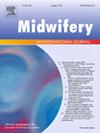Component of the short version of the breastfeeding self-efficacy scale (BSES-SF) as a predictor of breastfeeding duration
IF 2.6
3区 医学
Q1 NURSING
引用次数: 0
Abstract
Background
self-efficacy in breastfeeding influences the duration of breastfeeding. There is a validated scale to measure it, the Breastfeeding Self Efficacy Scale-Short Form (BSES-SF), developed by Dennis et al.
Aims
to examine the internal structure of the BSES-SF, verify if the score changes in the first months of lactation and if it is related to early cessation of breastfeeding.
Methods
at 24–48 h after birth and at 3 and 6 months, the 272 participants completed the BSES-SF and the type of lactation, sociodemographic and clinical variables were recorded. The construct validity of the scale was assessed by factorial analysis, the predictive validity using a multiple regression analysis, and the reliability by Cronbach's alpha coefficient.
Results
the factorial analysis reflected three components explaining 59.1 % of the variance confidence in the process of lactation, competence to manage breastfeeding, and motivation to breastfeed. The BSES-SF scale score increased throughout lactation, with a greater increment in mothers with exclusive or predominant breastfeeding. The confidence component increased at 3 and 6 months. Both confidence and competence reached significantly higher values in mothers with exclusive or predominant breastfeeding at 3 months. The multiple regression analysis, with the three dimensions of the scale and 6 other predictors, confirmed that the competence component is the best to predict breastfeeding maintenance (β: 0.479, p < 0.0001).
Discussion and conclusion
our results support a three-dimensional structure of the scale. Competence is the component that best predicts breastfeeding continuity at 6 months and is where strategies to improve breastfeeding rates should be directed.
短版母乳喂养自我效能感量表(BSES-SF)的成分是母乳喂养持续时间的预测指标。
背景:母乳喂养的自我效能感影响母乳喂养的持续时间。有一个有效的量表来衡量它,母乳喂养自我效能量表-简表(BSES-SF),由丹尼斯等人开发。目的:检查BSES-SF的内部结构,验证该评分是否在哺乳期的前几个月发生变化,是否与早期停止母乳喂养有关。方法:272名受试者在出生后24-48小时、3个月和6个月完成BSES-SF,记录泌乳类型、社会人口学和临床变量。量表的构念效度采用因子分析,预测效度采用多元回归分析,信度采用Cronbach’s alpha系数。结果:析因分析反映了三个组成部分,解释了59.1%的方差,即哺乳过程的置信度、管理母乳喂养的能力和母乳喂养的动机。BSES-SF量表评分在整个哺乳期增加,在纯母乳喂养或主要母乳喂养的母亲中增加更大。信心成分在3个月和6个月时增加。在3个月时,纯母乳喂养或主要母乳喂养的母亲的信心和能力都达到了显著更高的值。对量表的三个维度和其他6个预测因子进行多元回归分析,证实能力成分对母乳喂养维持的预测效果最好(β: 0.479, p < 0.0001)。讨论和结论:我们的结果支持一个三维结构的规模。能力是预测6个月母乳喂养连续性的最佳组成部分,也是提高母乳喂养率战略的指导方向。
本文章由计算机程序翻译,如有差异,请以英文原文为准。
求助全文
约1分钟内获得全文
求助全文
来源期刊

Midwifery
医学-护理
CiteScore
4.50
自引率
7.40%
发文量
221
审稿时长
13.4 weeks
期刊介绍:
Midwifery publishes the latest peer reviewed international research to inform the safety, quality, outcomes and experiences of pregnancy, birth and maternity care for childbearing women, their babies and families. The journal’s publications support midwives and maternity care providers to explore and develop their knowledge, skills and attitudes informed by best available evidence.
Midwifery provides an international, interdisciplinary forum for the publication, dissemination and discussion of advances in evidence, controversies and current research, and promotes continuing education through publication of systematic and other scholarly reviews and updates. Midwifery articles cover the cultural, clinical, psycho-social, sociological, epidemiological, education, managerial, workforce, organizational and technological areas of practice in preconception, maternal and infant care.
The journal welcomes the highest quality scholarly research that employs rigorous methodology. Midwifery is a leading international journal in midwifery and maternal health with a current impact factor of 1.861 (© Thomson Reuters Journal Citation Reports 2016) and employs a double-blind peer review process.
 求助内容:
求助内容: 应助结果提醒方式:
应助结果提醒方式:


